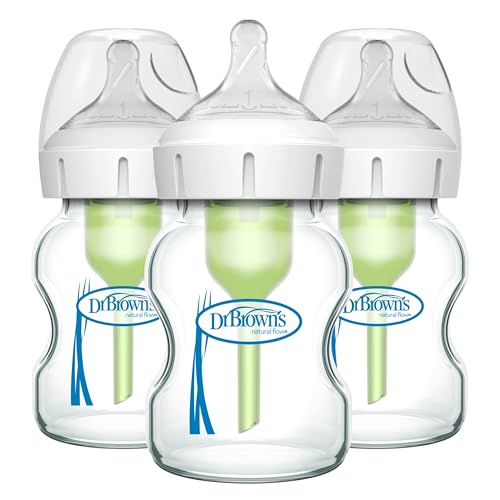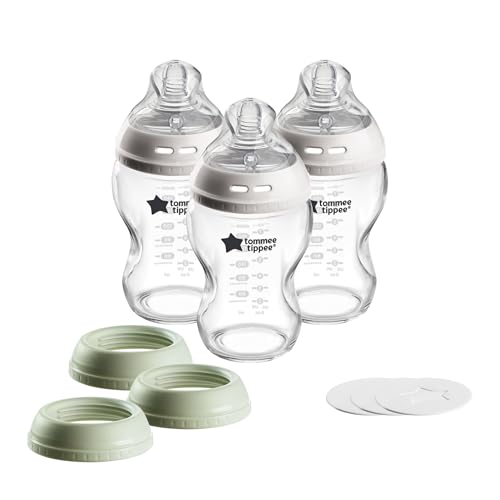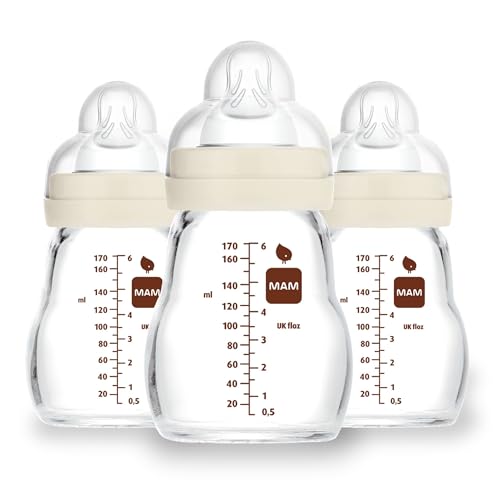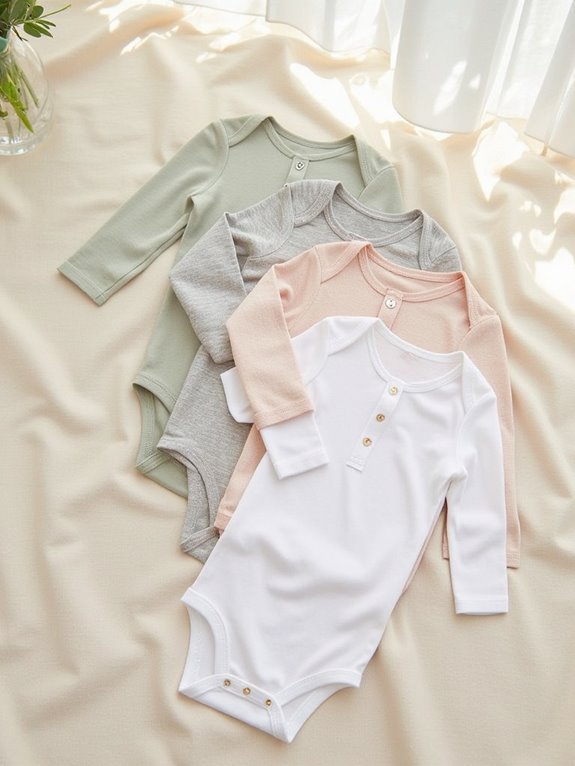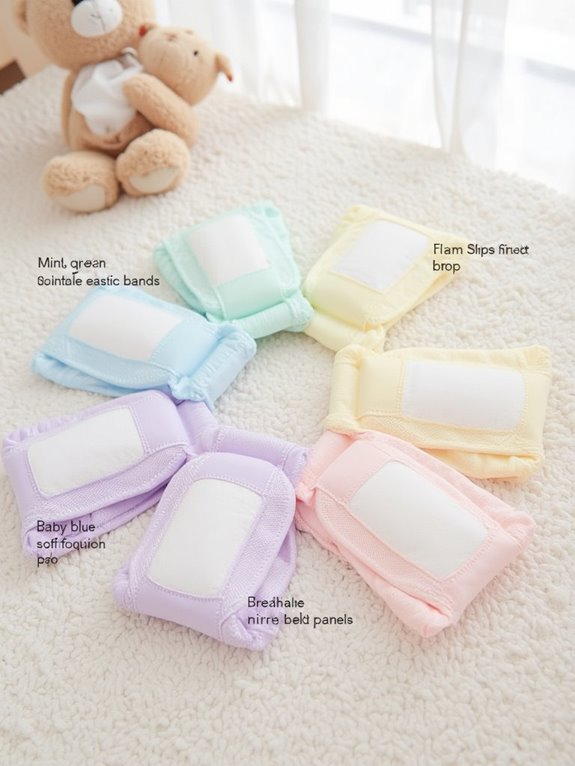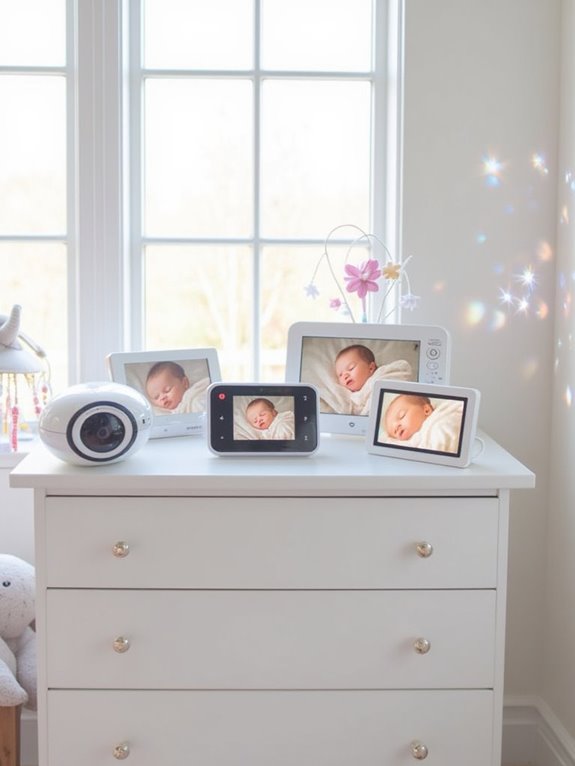Links below are affiliate links. We earn a commission on purchases at no extra cost to you. Although our opinions are based on curated research, we haven't used these products. Articles generated with AI.

The 5 Best Glass Baby Bottles of 2025, According to Parents and Pediatricians
The top glass baby bottles for 2025 prioritize safety and anti-colic features. Dr. Browns Natural Flow Wide-Neck leads with its proven internal vent system, while Tommee Tippee’s Natural Start offers a versatile 3-in-1 design. The Chicco Duo Hybrid combines glass and plastic durability, Dr. Browns Anti-Colic 8oz excels in temperature resistance, and MAM Feel Good provides spill-proof convenience. Each bottle features BPA-free materials and medical-grade glass construction. Our detailed analysis explores their unique advantages and specifications.
Key Takeaways
- Dr. Browns Natural Flow Glass Bottles lead with proven anti-colic venting and breast-like nipples for natural feeding transitions.
- Tommee Tippee Natural Start offers versatile 3-in-1 functionality using medical-grade glass and quick sterilization features.
- Chicco Duo Hybrid combines micro-thin glass with plastic, providing durability while maintaining glass benefits and multiple size options.
- MAM Feel Good Glass Bottles feature temperature-resistant glass construction with spill-proof caps and simple cleaning design.
- Dr. Browns Anti-Colic 8oz Glass Bottles provide clinical venting systems and heat-resistant glass for reliable feeding sessions.
Dr. Browns Natural Flow Wide-Neck Glass Baby Bottles (3 Pack, 5 oz)
Dr. Brown's Natural Flow Anti-Colic Options+ Wide-Neck Glass Baby Bottles 5 oz/150 mL, with Level 1...
- ANTI-COLIC GLASS BABY BOTTLE. Anti-Colic internal vent system is clinically proven to reduce colic. Decreases spit-up, burping and gas.
- CONSISTENT FLOW RATE. Vacuum-free feeding is closest to breastfeeding and Dr. Brown’s silicone nipples provide a consistent flow so babies can feed at their own pace.
- PRESERVES NUTRIENTS. The anti-colic vent system is proven to help preserve bottle milk nutrients and aids in digestion for a better night’s sleep.
Parents seeking a premium anti-colic solution will find Dr. Brown’s Natural Flow Wide-Neck Glass Baby Bottles deliver proven results. Their internal vent system reduces colic, spit-up, and gas while preserving milk nutrients for better digestion and sleep.
Key features:
- Level 1 slow-flow silicone nipples mimic breastfeeding
- Wide-neck design adapts to all feeding stages
- Removable vent system grows with your baby
- BPA-free, recyclable glass construction
- Dishwasher, microwave, and sterilizer safe
Each 3-pack includes 5 oz/150 mL bottles designed for infants 0+ months. You’ll appreciate the breast-like nipple shape that helps your baby transition smoothly between bottle and breast feeding.
Best For: Parents seeking premium glass bottles to reduce colic and gas while preserving nutrients, especially those transitioning between breast and bottle feeding.
Pros:
- Clinically proven internal vent system effectively reduces colic, gas, and spit-up
- High-quality, durable glass construction is eco-friendly and dishwasher safe
- Versatile design grows with baby, eliminating need for multiple bottle types
Cons:
- Glass bottles are heavier than plastic alternatives
- Multiple parts to clean due to the vent system
- Higher price point compared to standard baby bottles
Tommee Tippee Natural Start Glass Baby Bottle Set (9oz)
Sale
Tommee Tippee Natural Start 9 oz Glass Baby Bottles, Self Sterilizing, BPA & Phthalates Free, 0+...
- Safe Glass Baby Bottles: Made from durable, medical-grade glass that’s long-lasting, stain resistant and free from BPA, phthalates and toxins for safe, natural baby...
- Grows with baby: With three 9oz Natural Start glass bottles, three travel food jar lids and three cup rings to see baby from bottle feeding to weaning and then open cup...
- Natural Latch For Baby: Our silicone bottle nipples are shaped to encourage a natural latch, reducing air intake and preventing nipple confusion when switching between...
Looking for a versatile glass bottle that shifts from infancy through toddlerhood? The Tommee Tippee Natural Start Glass Baby Bottle Set (Model 549508) transforms from bottle to storage container to open cup. Made of medical-grade glass, these 9oz bottles feature breast-like nipples that flex and stretch for natural feeding.
Parents appreciate the bottle’s key safety features:
- Self-sterilizes in 3 minutes via microwave
- BPA-free materials
- Leakproof design with travel lids
- Vented nipples to reduce colic
- Dishwasher-safe construction
With 4.6/5 stars from nearly 3,000 reviews, these bottles excel at progressingbabies from breast to bottle. While some report nipple sticking issues, most praise the durability and cleaning ease.
Best For: Parents seeking an eco-friendly, versatile bottle system that transitions from infant feeding through toddler cups while prioritizing safety and natural feeding patterns.
Pros:
- Medical-grade glass construction is durable, sustainable, and prevents chemical leaching
- Versatile 3-in-1 design functions as bottle, storage container, and open cup
- Quick 3-minute microwave self-sterilization feature saves time and ensures safety
Cons:
- Nipples can get stuck or be difficult to attach properly
- Higher risk of breakage compared to plastic alternatives
- More expensive than standard plastic baby bottles
Chicco Duo Hybrid Baby Bottle Starter Gift Set – Pink
Sale
Chicco Duo Newborn Hybrid Baby Bottle Starter Gift Set with Invinci-Glass Inside and Plastic Outside...
- DUO, the first-of-its-kind hybrid baby bottle, provides the purity of glass and convenience of plastic in one unique bottle. A breakthrough medical glass technology...
- Baby’s milk touches pure glass – shields milk from plastic. Won’t shatter, chip, crack, or flake. Laser etched calibrations & decorations - no ink fading or...
- No nasty smells or aftertaste. Stays clear – won’t stain or discolor. Long-lasting, durable and breakproof. Lightweight and comfortable to hold for both parent and...
The Chicco Duo Hybrid Baby Bottle Starter Gift Set – Pink stands out as an ideal choice for families seeking the purity of glass with the durability of plastic. The innovative INVINCI-GLASS technology bonds micro-thin glass to premium plastic, creating a breakproof bottle that lets your baby’s milk touch only pure glass.
You’ll find this USA-made set includes:
- Two 5oz bottles with Stage 1 slow-flow nipples
- Two 9oz bottles with Stage 2 medium-flow nipples
- Two PhysioForma pacifiers (0-6 months) with sterilizing case
The bottles feature Intui-Latch nipples that mimic natural breastfeeding and anti-colic valves to reduce air intake. They’re dishwasher-safe, BPA-free, and compatible with bottle warmers and sterilizers.
Best For: Parents seeking a premium bottle-feeding solution that combines the purity of glass with the convenience of plastic, especially those transitioning between breast and bottle feeding.
Pros:
- Innovative hybrid design offers glass purity for milk contact while maintaining lightweight durability
- Complete starter set includes multiple bottle sizes and stage-appropriate nipples, plus pacifiers
- Anti-colic system and Intui-Latch nipples support natural feeding and reduce air intake
Cons:
- Higher price point compared to traditional plastic or glass bottles
- Limited color options available in the starter set
- May be heavier than pure plastic bottles, though lighter than pure glass
Dr. Browns Anti-Colic Glass Baby Bottle 8oz (2 Pack)
Dr. Brown's Natural Flow Anti-Colic Options+ Narrow Glass Baby Bottle 8 oz/250 mL, with Level 1 Slow...
- GLASS ANTI-COLIC BABY BOTTLE. Anti-Colic internal vent system is clinically proven to reduce colic. Decreases spit-up, burping and gas
- DURABLE BOROSILICATE GLASS. Dr. Brown's Glass bottles are heat and thermal shock-resistant, which can withstand hot and cold temperatures, along with gradual temperature...
- CONSISTENT FLOW RATE. Vacuum-free feeding is closest to breastfeeding and Dr. Brown's silicone nipples provide a consistent flow so babies can feed at their own pace.
Modern health-conscious families seeking safe, sustainable baby bottles will find an ideal solution in Dr. Brown’s Anti-Colic Glass Baby Bottles. These 8oz bottles feature a clinically-proven vent system that reduces colic, gas, and spit-up while preserving nutrients in milk or formula.
Made of BPA-free, heat-resistant glass, they’re built to last through multiple children. You’ll appreciate the Level 1 Slow Flow silicone nipples that mimic breastfeeding and promote natural latching. The bottles are dishwasher-safe, microwave-safe, and compatible with most breast pumps. While they’re heavier than plastic alternatives, their durability and superior cleaning properties make them worth the investment.
Best For: Health-conscious parents seeking a durable, eco-friendly bottle solution that helps reduce colic and gas while maintaining milk nutrients.
Pros:
- Clinically proven vent system effectively reduces colic, gas, and spit-up
- High-quality glass construction is long-lasting, odor-resistant, and free from harmful chemicals
- Compatible with most breast pumps and safe for dishwasher, microwave, and sterilization
Cons:
- Heavier than plastic bottles, which may be challenging for babies to hold
- Internal vent system requires thorough cleaning and can be time-consuming
- More expensive initial investment compared to plastic alternatives
MAM Feel Good Glass Baby Bottles (5oz, 3 Pack)
Sale
MAM Premium Glass Baby Bottles, Easy Switch Between Breast and Bottle, Feel Good Slow Flow, Newborn...
- Premium Glass: Made from high-quality, temperature-resistant glass, safe for heating, dishwasher cleaning, and high-temperature sterilization, ensuring durability and...
- 94% Nipple Acceptance: With a soft SkinSoft nipple, MAM baby bottles newborn are accepted by 94% of babies, making it easier to switch between breastfeeding and baby...
- Spill-proof Dust Cap: Each glass bottle features a protective dust cap that keeps the nipple clean and doubles as a measuring cup. Designed to be leak-proof for travel...
Parents seeking a safe changeover between breast and bottle feeding will find MAM Feel Good Glass Baby Bottles perfectly suited to their needs. These 5oz bottles feature temperature-resistant glass construction and an elongated silicone nipple that mimics natural breastfeeding.
Key features you’ll appreciate:
- BPA, BPS, and lead-free materials for your baby’s safety
- Dishwasher-safe and microwaveable glass
- Three-piece design for easy cleaning
- Vented nipples to reduce colic
- Spill-proof dust cap doubles as a measuring cup
With a 4.6/5 star rating from 466 reviews, these Czech-made bottles offer durability and convenience. You’ll find the printed measurements helpful, though they may fade over time with regular use. The bottles are currently available as a 3-pack with a 30-day return policy.
Best For: Parents transitioning between breast and bottle feeding who prioritize safe, high-quality materials and want an easy-to-clean glass bottle option.
Pros:
- High-quality temperature-resistant glass that’s both durable and chemical-free
- Simple three-piece design makes cleaning and assembly straightforward
- Innovative dust cap doubles as a measuring cup with integrated scale
Cons:
- Measurement markings may fade over time with regular use
- Flow rate might be too fast for some babies
- More expensive than plastic bottle alternatives
Factors to Consider When Choosing Glass Baby Bottles

When you’re selecting glass baby bottles in 2025, you’ll want to examine several critical factors that directly impact your baby’s feeding experience and safety. You’ll need to carefully evaluate the bottle’s material quality and durability, anti-colic features, nipple flow options, ease of cleaning, and the practical aspects of size and weight. These key considerations will help you make an informed decision that guarantees both your baby’s comfort and your peace of mind while handling the bottles during daily feedings.
Material Quality and Durability
Since safety remains paramount in baby products, understanding glass bottle material quality and durability is essential for making informed choices. You’ll want to look for bottles made from borosilicate or medical-grade glass, which can handle temperature changes without cracking.
Key durability features to check:
- Heat-resistant glass construction
- Micro-thin protective plastic coating or reinforced design
- Sturdy, leak-proof lids
- Reinforced bottle necks to prevent chipping
- Dishwasher and sterilizer compatibility
These quality indicators ensure your baby’s bottle won’t easily break from drops or impacts. The best glass bottles won’t stain, retain odors, or become discolored over time. They’ll maintain their clarity through repeated washing and sterilization cycles, making them a reliable long-term investment in your baby’s feeding routine.
Anti-Colic Vent Design
Beyond material strength, the anti-colic vent design plays a key role in your baby’s feeding comfort and health. When evaluating glass bottles, you’ll want to look for internal venting systems that create vacuum-free milk flow, similar to natural breastfeeding.
Key features to check:
- Integrated vents that minimize air ingestion during feeding
- Easy-to-clean components that prevent milk residue buildup
- Design that reduces milk agitation to preserve nutrients
An effective anti-colic system should noticeably decrease:
- Excessive burping
- Spit-up frequency
- Gas discomfort
- Colic symptoms
You’ll find that bottles with well-engineered venting promote better feeding rhythm and proper latching. The best designs maintain their effectiveness through multiple cleanings while ensuring that your baby swallows less air during each feeding session.
Nipple Flow Options
The right nipple flow rate stands as a critical factor in your baby’s feeding success with glass bottles. You’ll need to match the flow rate to your infant’s age and feeding abilities to ensure safe, comfortable feedings.
Choose from three essential flow rates:
- Slow Flow: Best for newborns, preventing overfeeding and choking by closely matching breastfeeding patterns
- Medium Flow: Ideal for growing babies who can handle increased milk volume
- Fast Flow: Suitable for older infants requiring larger feeding volumes
When selecting nipple flow options, consider:
- Your baby’s age and feeding development
- Whether they’re exclusively bottle-fed or combining breast and bottle
- Signs of feeding difficulty (coughing, choking, or frustration)
- Presence of colic or excessive gas
Look for vented nipple designs that reduce air intake during feedings.
Cleaning and Sterilization
After selecting the right nipple flow, maintaining proper hygiene for your glass bottles becomes a top priority. You’ll find that glass bottles offer several advantages when it comes to cleaning and sterilization:
- They’re compatible with all major sterilization methods including boiling, steam, and microwave systems
- Wide-neck designs make it easy to reach all interior surfaces during manual cleaning
- Fewer components mean fewer places where milk residue can hide
For maximum safety, especially with newborns or babies with compromised immune systems, you’ll need to:
- Clean thoroughly with warm, soapy water after each use
- Run through your dishwasher’s sanitize cycle, or
- Use a dedicated bottle sterilizer
The simpler construction of glass bottles helps ensure thorough cleaning while maintaining the bottles’ clarity and safety standards.
Size and Weight
Selecting appropriately sized glass bottles makes a critical difference in your baby’s feeding experience. You’ll want to weigh both bottle capacity and weight when making your choice:
Bottle Capacity:
- 9 oz bottles: Best for older infants who need larger portions
- 5 oz bottles: Ideal for newborns and night feedings to minimize waste
Weight Considerations:
- Heavier glass bottles can cause hand fatigue during extended feeding sessions
- Weight becomes especially important if you’re feeding multiple children
- Light bottles offer better portability for travel and on-the-go use
When choosing between sizes, consider your baby’s age and feeding patterns. If you’re looking for maximum versatility, you might want to keep both sizes on hand – smaller ones for early months and larger ones as your baby grows.
Temperature Resistance Range
Since your baby’s safety depends heavily on proper sterilization, understanding temperature resistance ratings becomes essential when selecting glass bottles. You’ll want to make certain your chosen bottle can withstand temperatures between 212°F (100°C) and 302°F (150°C) for safe sterilization and heating.
Key Temperature Guidelines:
- Minimum safe range: 212°F (100°C) for boiling sterilization
- Recommended range: Up to 302°F (150°C) for steam sterilization
- Premium bottles: Up to 450°F (232°C) with borosilicate glass
Before purchasing, always check the manufacturer’s specifications for maximum temperature tolerance. Bottles with lower temperature resistance won’t handle repeated sterilization well and might crack during heating. For the safest option, look for borosilicate glass bottles, which offer superior heat resistance and durability through multiple sterilization cycles.
Breast-Like Nipple Shape
When shifting between breast and bottle feeding, the nipple shape plays a crucial role in your baby’s acceptance and comfort. Modern breast-like nipples feature a wide silicone base and natural contours that mimic a mother’s breast, helping your baby maintain proper tongue and lip positioning during feeds.
Key Benefits:
- Reduces nipple confusion between breast and bottle
- Promotes natural sucking rhythm with controlled flow
- Supports proper latch and feeding mechanics
- Compatible with multiple bottle brands
When selecting a glass bottle, you’ll want to guarantee it comes with a high-quality breast-like nipple or is compatible with your preferred nipple brand. Look for options that offer different flow rates to match your baby’s developmental stage. The right nipple shape will help create a seamless transition between feeding methods while maintaining proper feeding techniques.
Safety Certifications
Parents seeking safe glass baby bottles must verify proper safety certifications before making a purchase. Look for bottles that display certification marks from trusted organizations like ASTM, FDA, and CPSC, which ensure the product meets strict safety requirements.
Key certifications to check:
- Material Safety: Verify BPA-free, BPS-free, phthalate-free, and lead-free certifications
- Temperature Resistance: Check for microwave, dishwasher, and sterilizer-safe ratings
- Durability Testing: Confirm breakage resistance certification
- Manufacturing Standards: Look for quality control documentation
You’ll find these safety marks on the product packaging or documentation. Don’t compromise on certification requirements – they’re your assurance that the bottle has undergone rigorous testing. When comparing different brands, make the presence of multiple safety certifications a priority in your decision-making process.
Frequently Asked Questions
How Long Can Breast Milk Be Stored in Glass Baby Bottles?
You can safely store breast milk in glass bottles following these timeframes:
- Room temperature (77°F/25°C): Up to 4 hours
- Refrigerator (40°F/4°C): Up to 4 days
- Freezer (0°F/-18°C): Up to 6 months
When storing milk, you’ll want to leave some space at the top of the bottle since breast milk expands when frozen. Always label your bottles with the date and use the oldest milk first. Don’t refreeze thawed breast milk.
Can Glass Baby Bottles Be Heated in the Microwave?
Would you risk your baby’s safety for convenience? While you can technically microwave glass baby bottles, it’s not recommended for several important reasons:
- Microwaving creates dangerous “hot spots” that can burn your baby
- Uneven heating may crack or shatter the glass
- The intense heat can destroy valuable nutrients in breast milk or formula
Instead, warm bottles safely by:
- Using a bottle warmer
- Placing in a bowl of warm water
- Running under warm tap water
At What Temperature Do Glass Baby Bottles Break?
Glass baby bottles can typically withstand temperatures between -4°F and 320°F (-20°C to 160°C) before risking breakage. However, you’ll want to avoid extreme temperature changes, as thermal shock can cause the glass to break at much lower temperatures. To stay safe, don’t expose your glass bottles to temperature differences greater than 122°F (50°C). This means you shouldn’t move bottles directly from the refrigerator to hot water or vice versa.
How Often Should Glass Baby Bottles Be Replaced?
You should replace your glass baby bottles every 4-6 months, even if they don’t show visible damage. Here’s why:
- Glass can develop microscopic cracks that aren’t visible
- Repeated sterilization and temperature changes weaken the glass
- Frequent washing may cause buildup in hard-to-clean areas
If you notice any chips, cracks, or scratches, replace the bottle immediately. Don’t wait for the regular replacement schedule – these defects can harbor bacteria and compromise your baby’s safety.
Are Glass Baby Bottles Dishwasher-Safe at High Temperatures?
Like diamonds under pressure, glass baby bottles can withstand high temperatures, but you’ll need to follow specific guidelines. Most glass bottles are dishwasher-safe up to 180°F (82°C), but you should:
- Place bottles on the top rack only
- Avoid extreme temperature changes that could cause thermal shock
- Check manufacturer’s instructions first
- Remove silicone sleeves before washing
For maximum safety, you’ll want to inspect bottles after each wash for chips or cracks before reusing.

